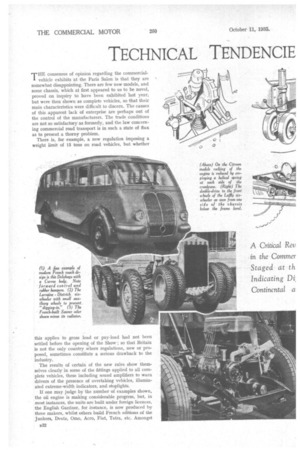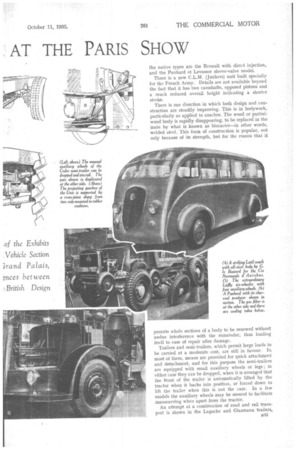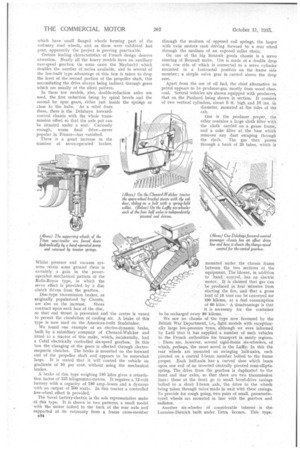TECHNICAL TENDENCIE AT THE PARIS SHOW
Page 46

Page 47

Page 48

Page 49

If you've noticed an error in this article please click here to report it so we can fix it.
THE consensus of opinion regarding the commercialvehicle exhibits at the Paris Salon is that they are somewhat disappointing. There are few new models, and some chassis, which at first appeared to us to be novel, proved on inquiry to have been exhibited last year, but were then shown as complete vehicles, so that their main characteristics were difficult to discern. The causes of this apparent lack of enterprise are perhaps out of the control of the manufacturers. The trade conditions are not so satisfactory as formerly, and. the law concerning commercial road transport is in such a state of flux as to present a thorny problem.
There is, for example, a new regulation imposing a weight limit of 15 tons on road vehicles, but whether this applies to gross load or pay-load had not been settled before the opening of the Show ; so that Britain is not the only country where regulations, new or proposed, sometimes constitute a serious drawback to the industry.
The results of certain of the new rules show themselves clearly in some of the fittings applied to all complete vehicles, these including sound amplifiers to warn drivers of the presence of overtaking vehicles, illuminated extreme-width indicators, and stoplights.
If one may judge by the number of examples shown, the oil engine is making considerable progress, but, in most instances, the units are built under foreign licences, the English Gardner, for instance, is now produced by three makers, whilst others build French editions _of the Junkers, Deutz, Omo, Acro, Fiat, Tatra, etc. Amongst B32 the native types are the Renault with direct injection. and the Panhard et Levassor sleeve-valve model.
There is a new C.L.M. (Junkers) unit built specially for the French Army. Details are not available beyond the fact that it has two camshafts, opposed pistons and a much reduced overall height indicating a shorter stroke.
There is one direction in which both design and construction are steadily improving. This is in bodywork, particularly as applied to coaches. The wood or partialwood body is rapidly disappearing, to be replaced in the main by what is known as blocacier—in other words, welded steel. This form of construction is popular, not only because of its strength, but for the reason that it permits whole sections of a body to be renewed without undue interference with the remainder, thus lending itself to ease of repair after damage. Trailers and semi-trailers, which permit large loads to be carried at a moderate cost, are still in favour. In, most of them, means are provided for quick attachment and detachment, and for this purpose the semi-trailers are equipped with small auxiliary wheels or legs ; in either case they can be dropped, when it is arranged that the front of the trailer is automatically lifted by the tractor when it backs into position, or forced down to lift the trailer when this is not the case. In a few models the auxiliary wheels may be steered to facilitate manoeuvring when apart from the tractor. An attempt at a combination of road and rail transport is shown in the Lagache and Glazmann trailers, n33
which have 'small flanged wheels forming part of the ordinary road wheels, and as these were exhibited last year, apparently the project is proving practicable.
Certain leading characteristics of French design deserve attention. Nearly all the heavy models have an auxiliary two-speed gearbox (in some cases the Maybach) which doubles the number of ratios available, and in several of the low-built type advantage of this box is taken to drop the level of the second portion of the propeller shaft, this necessitating the drive always being indirect through gears which are usually of the silent pattern.
In these low models, also, double-reduction axles are used, the first reduction being by spiral bevels and the second by spur gears, either just inside the springs or close to the hubs. As a relief from these, there is the Delahaye forwardcontrol chassis with the whole transmission offset so that the axle pot can be situated under a seat. Curiously enough, worm final drive—never popular in France—has vanished.
There is a great increase in the number of servo-operated brakes.
.Whilst pressure and vacuum systems retain some ground there is certainly, a gain in the poweroperated mechanical pattern of the Rolls-Royce type, in which the servo effect is provided by a disc clutch driven from the gearbox.
• Disc-type transmission brakes, as originally popularized by Citroas, are also on the increase. Shoes contract upon each face of the disc, so that end thrust is prevented and the centre is vaned to permit the circulation of cooling air. A brake of this type is now used on the American-built Studebaker.
We found one example of an electro-dynamic. brake, built by a subsidiary company of Chenard-Walcker and fitted to a tractor of this make, which, incidentally, had a Cotal electrically controlled six-speed gearbox. In this box the changing of the gears is effected through electromagnetic clutches. The brake is mounted on the forward end of the propeller shaft and appears to be somewhat large.. It is stated that it will control the vehicle on gradients of 10 per cent, without using the mechanical brakes.
A brake of this type weighing 180 kilos gives a retardation factor of 125 kilogramme-metres. It requires a 12-volt battery with a capacity of 180 amp.-hours and a dynamo with an output of MO watts. In this tractor a controlled free-wheel effect is provided.
The Sovel battery-electric is the sole representative make of this type. It is shown in two patterns, a small model with the motor bolted to the hack of the rear axle and supported at its extremity from a frame cross-member
534
through the medium of opposed coil springs, the larger with twin motors each .driving forward to a rear wheel through the medium of an exposed roller chain.
On one of the big Renault goods chassis is a servo steering of Renault make. Use is made of a double drop arm, one side of which is connected to a servo cylinder mounted in a horizontal position on the frame side member; a simple valve gear is carried above the drop arm.
Apart from the use of oil fuel, the chief alternative to petrol appears to be producer-gas, mostly from wood charcoal. Several vehicles are shown equipped with producers, that on the Panhard being shown in section. It consists of two vertical cylinders, about 6 ft. high and 18. ins, in diameter, mounted at the sides of the cab.
One is the producer proper, the other contains a large cloth filter with the cloth carried on a gauze frame, and a coke filter at the base which removes any dust escaping through the cloth. The gas then passes through a bank of 20 tubes, which is mounted under the chassis frame between the two sections of the equipment. The blower, in addition to hand control, has an electric motor. It is claimed that gas can be produced in four minutes from starting the fire, and That a gross load of 15 tons can be conveyed for 100 kiloms, at a fuel consumption of 60 kilos: A disadvantage is that it is necessary for the container to be recharged every 80 kiloms.
We saw no chassis of the type now favoured by the British War Department, i.e., light models with exceptionally large low-pressure tyres, although we were informed by Latil that it has supplied a number of such vehicles to the French authorities for transport in sandy regions.
There are, however, several rigid-frame six-wheelers, of which, perhaps, the most novel is the Lafily. In this the sear wheels are mounted on swinging half-axles, each pivoted on a central I-beam member bolted to the frame proper. Each half-axle has a curved shoe which bears upon one end of an inverted centrally pivoted semi-elliptic spring. The drive from the gearbox is duplicated to the front and rear axles, so that there are two transmission lines ; those at the front go to small bevel-drive casings bolted to a short I-beam axle, the drive to the wheels being taken through tubes made in unit with these casings. To provide for rough going, two pairs of small, pneumatictyred. wheels wheels are mounted in line with the gearbox and radiator.
Another six-wheeler of considerable interest is the Lorraine-Dietrich built under Tatra licence. This type. with its tubular backbone, is well known to our readers. It also has small auxiliary wheels mounted about 15 ins. from the ground and in line with the radiator.
We saw only one example of one-shot lubrication. This was on a Citroen.
Some French designers appear to have a partiality for very narrow frames, even on large models. In the main, however, they are strongly built with large cross-members and, often, additional stays. In most cases the side members are dropped at about the dash and arc arched over the back axle.
The Citroen frame is unusual, as each welded side member is of box section with the outer side extended above and below the rest of the box, thus giving additional strength in the vertical direction.
The provision of extra leaves above the laminated springs at the rear is a method of adjusting the springing to the load which is to be found on many chassis in the heavier classes. Particular examples are the Berliet, Somua, Unic Laffiy and Renault. In most cases the additional leaves are immediately above the main springs, but in a few, where the latter are underslung, the others are mounted above the axle.
Considerable use is made of rubber for engine mounting, and on the Willeme even the headlamp standards are carried in rubber bushes. On the Somua the rear of the engine is supported on 5-in, rubber rings in frame brackets, whilst on the Panhard et Lcvassor the rear of the gearbox is carried in a rubber ring held by a bracket bolted to a cross-member ; the ring is actually located around the spherical joint at the front end of the torque tube. Rubber cushions are also provided for the two rods constituting an additional support for the gearbox on the Unic, the rods passing through the side members, as shown in a sketch.
Reverting to brakes, ,perhaps the most interesting arrangement is to be found on a Bernard chassis. This has the Rolls-type servo operating two Lockheed pumps which control the brakes diagonally on the four wheels. The hand brake is of the wind-up type with a chain connected to a steel strip passing along the chassis centre to a whipple tree. From this, two rods pass to &multiplying levers mounted horizontally and passing through the frame side-members well behind the rear axle; further rods are then brought forward and connected te the ends of levers controlling earns at each side of the shoes. This doublecam control is apparently necessitated by the presence of the Lockheed shoe-operating cylinders, but the arrangement appears to be somewhat complicated.
The wind-up brake with a hand lever connected to a wheel and pawl device is favoured on many vehicles, even in some cases for operating the brakes on four-wheelers, and not particularly for trailer work. One huge Renault tractor and trailer, each portion having a bulbans body, has quite a capacious loading space behind the driver's seat, so that the tractor is really converted into a short
wheelbase lorry of useful capacity. Reference may be made to the latest Michelin tyres in which non-skid indentations alternate with waved cuts about in. deep, the advantages of which have been shown in the Pneugrippa tyre-cutting process, although in this the cuts are straight.
On the largest Pan hard et Levassor, just below the forward end of the propeller-shaft torque tube, is mounted a torsion bar with 18-in, arms, the forward ends of which are carried in brackets on the frame side members; the purpose of the device is to act as a stabilizer.
Chatting with M. Andre Lireux, managing director of the Cie. Normande d'Autobus, he informed us that the body by G. le Bastard, of Rouen, on the Latil coach was designed at his request on the principles utilized in the Green Line coaches run by London Transport. It is of welded ;steel with . the seats and luggage racks of tubular steel, and above the windscreen are further lights following the line of the roof. The rear corner windows are curved, and the cushions are Dunlopillo.




























































































